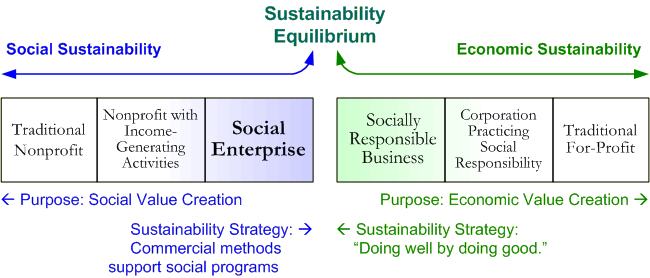Two distinct families of organizations reside on the hybrid spectrum. The characteristic that separates the two groups is purpose.
Profit (shareholder return) is the primary purpose of socially responsible businesses and corporations practicing social responsibly, whereas social impact is the primary purpose of social enterprises and nonprofits with income-generating activities. This difference is central to the organization’s ethos and activities. For this reason, organizations rarely evolve or transform in type along the full spectrum. Those that transform from social enterprise to socially responsible company or visa-versa must first reorient their primary purpose then realign their organization.
Nonprofits are founded to create social value, however, financial sustainability cannot be achieved without external or self-generated funds. For-profits are established to create economic value, yet often must make social contributions to survive in the marketplace. Therefore, both types of hybrids pursue dual value creation strategies to achieve sustainability equilibrium. Nonprofits integrate commercial methods to support their social purpose and for-profits incorporate social programs to achieve their profit making objectives.

As a hybrid, the social enterprise is driven by two strong forces. First, the nature of the desired social change often benefits from an innovative, entrepreneurial, or enterprise-based solution. Second, the sustainability of the organization and its services requires diversification of its funding stream, often including the creation of earned income.1
Distinguished by their dual value creation2 properties--economic value and social value--social enterprises have the following characteristics:
- Use business tools and approaches to achieve social objectives
- Blend social and commercial capital and methods3
- Create social and economic value
- Generate income from commercial activities to fund social programs
- Market-driven and mission-led
- Measure financial performance and social impact
- Meet financial goals in way that contributes to the public good
- Enjoy financial freedom from unrestricted income
- Incorporate enterprise strategically to accomplish mission
Duality of Objectives
 Social Objectives aimed at mission accomplishment (social value creation) vary widely depending the organization’s mission and sector. Examples include economic opportunities for the poor, employment for the disabled, environmental conservation, education, human rights protection, strengthening civil society, etc.
Social Objectives aimed at mission accomplishment (social value creation) vary widely depending the organization’s mission and sector. Examples include economic opportunities for the poor, employment for the disabled, environmental conservation, education, human rights protection, strengthening civil society, etc.
Financial Objectives focused on financial sustainability (economic value creation) vary according to funding needs and business model. Financial measures are drawn from both private and nonprofit practice. Examples include cost recovery of social service, diversifying grant funding with earned income, self-financing programs or making a profit to subsidize the organization's operations.
Blended Value
The concept of "blended value"4 arises from the notion that value has within it three component parts: economic, social, and environmental. While traditionally people have thought of nonprofits being responsible for social and environmental value and for-profits for economic value; in fact both types of organizations generate all three value sets.
The rise of social enterprise, corporate social responsibility, sohttps://vesting, and sustainable development are all examples of how various actors are pursuing a blend of financial, social, and environmental value.5 The blended value proposition is drawn from the belief that "value" is inherently whole; hence this school of thought is moving from measuring multiple bottom lines to focusing on a single value sign-blended value-or "total value" creation.
More information about Blended Value is available on the Blended Value Map website.
- 1Reis, Tom. Unleashing New Resources and Entrepreneurship for the Common Good: A Scan, Synthesis, and Scenario for Action. W.K. Kellogg Foundation, January 1999.
- 2Formerly referred to as double bottom line concept; double bottom line was dropped in favor of a new more holistic value creation approach (see blended value). Many proponents of social enterprise, social investing, corporate social responsibility, and venture philanthropy subscribe to the triple bottom line which includes environmental impact along with economic and social impact. The intent of this typology is to simplify the concepts, rather than to discount the significance of environmental impacts. For our purposes environment impacts have been included within social impact category.
- 3Adapted from Gregory Dees, Enterprising Nonprofits, Harvard Business Review, January-February 1998.
- 4For more information see, Blended Value Proposition: Integrating Social and Financial Returns, California Management Review, Vol. 45, No. 4, Summer 2003.
- 5Excerpted from Mapping the Blending Value Proposition, Jed Emerson and Sheila Bonni, 2003.
